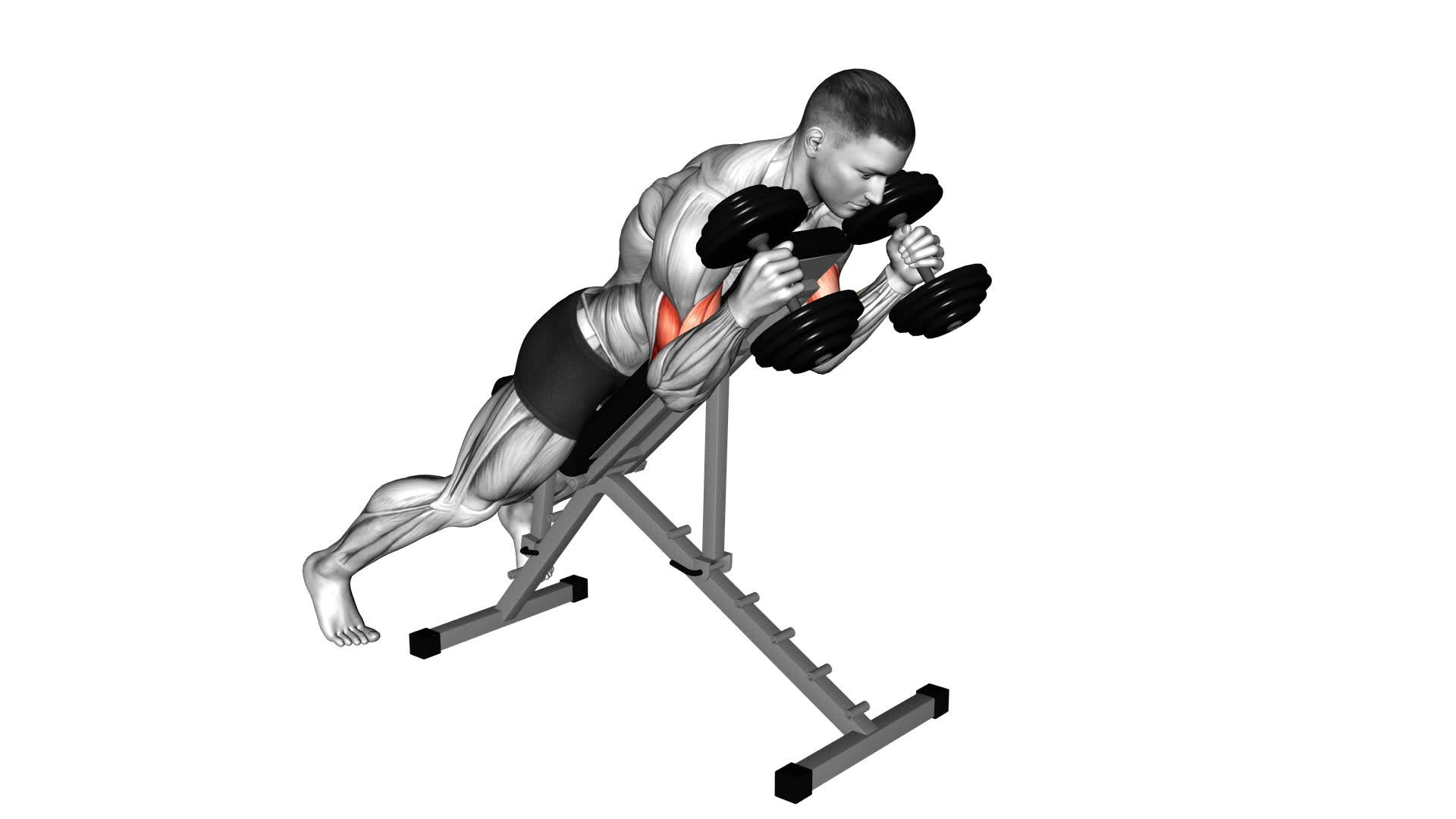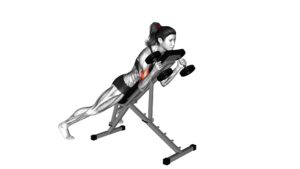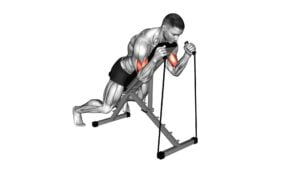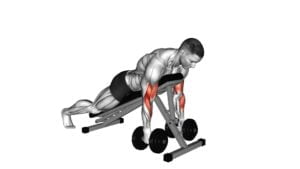Dumbbell Prone Incline Hammer Curl – Video Exercise Guide & Tips

Looking to build and tone your biceps? The dumbbell prone incline hammer curl is the exercise for you. In this video exercise guide, we'll show you the proper form and technique to get the most out of this move.
Watch This Exercise Video
You'll also learn variations and progressions to keep challenging yourself. Avoid common mistakes and maximize your results by following our tips.
Get ready to pump up those biceps with the dumbbell prone incline hammer curl!
Key Takeaways
- Dumbbell Prone Incline Hammer Curl targets biceps from a different angle for greater muscle activation and growth.
- Maintaining proper form and technique is crucial for maximizing muscle recruitment and reducing joint strain.
- The incline position of this exercise targets different muscle groups compared to traditional flat exercises and promotes better posture and core engagement.
- Incorporating variations and progressions in the exercise can prevent plateaus and keep workouts challenging and effective.
Benefits of Dumbbell Prone Incline Hammer Curl
You will experience significant gains in your bicep strength and size by incorporating the dumbbell prone incline hammer curl into your workout routine. One of the main benefits of performing this exercise in an incline position is that it targets your biceps from a different angle, leading to greater muscle activation and growth. The incline position also helps to isolate the biceps, reducing the involvement of other muscles and allowing for a more focused workout.
To maximize your results with the dumbbell prone incline hammer curl, there are a few tips you should keep in mind. First, make sure to use a weight that challenges you but still allows you to maintain proper form. This will ensure that you're effectively stimulating your bicep muscles without risking injury. Additionally, focus on controlling the movement throughout the exercise, both on the way up and on the way down. This will enhance muscle activation and increase the effectiveness of the exercise. Finally, remember to breathe properly and maintain a steady pace throughout your sets.
With the benefits of the incline position and these tips for maximizing results in mind, now let's move on to discussing the proper form and technique for the dumbbell prone incline hammer curl.
Proper Form and Technique for Dumbbell Prone Incline Hammer Curl
To execute the dumbbell prone incline hammer curl with proper form and technique, it's crucial to focus on the positioning of your elbows. Keep your elbows close to your sides throughout the exercise to maximize the engagement of your biceps and minimize strain on your shoulders.
Additionally, the incline position of the bench provides added benefits by targeting the upper portion of your biceps and enhancing muscle activation.
Elbow Positioning Importance
Maintaining proper elbow positioning is crucial for executing the dumbbell prone incline hammer curl with correct form and technique. Here are four reasons why elbow alignment is important for maximizing muscle activation during this exercise:
- Efficient muscle recruitment: When your elbows are properly aligned, the biceps brachii, brachialis, and brachioradialis muscles can work together more effectively, leading to greater muscle activation and strength gains.
- Reduced strain on the joints: Proper elbow positioning helps distribute the load evenly throughout the muscles and joints involved, reducing the risk of strain or injury.
- Improved stability: Aligning your elbows with your shoulders and wrists provides a stable foundation for the movement, allowing you to lift heavier weights and maintain control throughout the exercise.
- Optimal range of motion: By keeping your elbows in the correct position, you ensure that the muscles are working through their full range of motion, maximizing their potential for growth and development.
Benefits of Incline Position
To maximize the benefits of the incline position for the dumbbell prone incline hammer curl, focus on maintaining proper form and technique.
Incline exercises provide a unique advantage by targeting different muscle groups compared to traditional flat exercises. The incline position increases the activation of the biceps brachii and brachialis muscles, which are the primary muscles involved in the hammer curl movement.
By placing your body at an incline, you create a greater stretch on these muscles, leading to increased muscle activation and growth. Additionally, the incline position also promotes better posture and core engagement, as it requires you to stabilize your body throughout the exercise.
Variations and Progressions for Dumbbell Prone Incline Hammer Curl
As you progress in your dumbbell prone incline hammer curl routine, you can incorporate variations and progressions to challenge your muscles even more. Here are four variations and progressions you can try:
- Increase the weight: Once you feel comfortable with a certain weight, gradually increase the resistance. This will help build strength and muscle size over time.
- Change the incline angle: Adjust the incline bench to different angles to target different parts of your biceps. A steeper incline will emphasize the long head of the biceps, while a lower incline will target the short head.
- Perform drop sets: After completing a set with a challenging weight, immediately decrease the weight and continue the exercise without resting. This technique helps to increase muscle endurance and stimulate further muscle growth.
- Use a stability ball: Instead of using an incline bench, try performing the dumbbell prone incline hammer curl on a stability ball. This will engage your core muscles and challenge your balance, adding an extra dimension to the exercise.
Incorporating these variations and progressions into your dumbbell prone incline hammer curl routine will help prevent plateaus and keep your workouts challenging and effective. Remember to always use proper form and listen to your body to avoid injury.
Common Mistakes to Avoid During Dumbbell Prone Incline Hammer Curl
When performing the dumbbell prone incline hammer curl, it's important to pay attention to your grip positioning. Make sure that your hands are secure on the dumbbells and that you maintain a firm grip throughout the exercise.
Another common mistake to avoid isn't stabilizing your elbows properly. Keep your elbows close to your body and avoid swinging them during the movement.
Lastly, ensure that you perform the exercise through a full range of motion, fully extending your arms at the bottom and squeezing your biceps at the top.
Grip Positioning Importance
During the dumbbell prone incline hammer curl, ensure that you maintain a proper grip position to avoid common mistakes. The importance of grip can't be overstated, as it plays a crucial role in maximizing the effectiveness of this exercise and preventing injuries.
Here are four key points to remember about grip positioning:
- Hold the dumbbells with a neutral grip, palms facing each other. This grip allows for a more natural movement pattern and targets the muscles of the forearms and upper arms effectively.
- Avoid gripping the dumbbells too tightly. While grip strength training is important, squeezing the dumbbells excessively can lead to unnecessary tension and fatigue in the forearms, diminishing the focus on the targeted muscles.
- Keep your wrists straight throughout the movement. Bending the wrists can put unnecessary stress on the joint and increase the risk of injury.
- Maintain a firm but relaxed grip. This will allow you to control the dumbbells better and perform the exercise with proper form.
By following these grip positioning guidelines, you can optimize your performance during the dumbbell prone incline hammer curl and minimize the risk of injury.
Now, let's move on to the next section, where we'll discuss the elbow stability technique.
Elbow Stability Technique
To maintain proper form and avoid common mistakes during the dumbbell prone incline hammer curl, focus on maintaining stability in your elbows. Elbow stability is crucial for effectively targeting the muscles in your arms and preventing injury.
One way to improve elbow stability is by performing specific exercises that strengthen the muscles surrounding the elbow joint. Incorporating exercises such as wrist curls, reverse curls, and tricep pushdowns into your routine can help improve the stability and strength of your elbows.
Additionally, make sure to avoid swinging or using momentum during the exercise, as this can put unnecessary strain on the elbows. By prioritizing elbow stability and incorporating strengthening exercises, you can perform the dumbbell prone incline hammer curl with proper form and maximize your results.
Now, let's move on to the next section and discuss the importance of maintaining a full range of motion during this exercise.
Full Range of Motion
To maintain proper form and prevent injury during the dumbbell prone incline hammer curl, it's important to focus on maintaining a full range of motion in your arm movements. Here are some common mistakes to avoid when it comes to range of motion in this exercise:
- Partial range of motion: Avoid only moving your arms partially, as this limits the effectiveness of the exercise and reduces muscle engagement.
- Swinging the weights: Make sure to control the movement and avoid swinging the dumbbells. This not only reduces the range of motion but also puts strain on your joints.
- Locking the elbows: Keep your elbows slightly bent throughout the exercise to maintain tension on the muscles and prevent joint stress.
- Rushing the exercise: Take your time and perform the exercise in a slow and controlled manner. This ensures that you're getting the full benefit of the exercise and reduces the risk of injury.
Tips for Maximizing Your Results With Dumbbell Prone Incline Hammer Curl
To maximize your results with the dumbbell prone incline hammer curl, it's important that you maintain proper form throughout the exercise. This will ensure that you're effectively targeting your biceps and improving your upper body strength.
When performing the dumbbell prone incline hammer curl, start by lying face down on an incline bench with a dumbbell in each hand, palms facing your torso. Keep your upper arms stationary and curl the weights while contracting your biceps.
While curling, make sure to keep your elbows close to your body and avoid any swinging or jerking motions. Additionally, it's important to fully extend your arms at the bottom of the movement and squeeze your biceps at the top.
By maintaining proper form and focusing on controlled movements, you'll be able to maximize your bicep gains and improve your upper body strength.
Now, let's move on to a sample dumbbell prone incline hammer curl workout routine.
Sample Dumbbell Prone Incline Hammer Curl Workout Routine
To perform a sample dumbbell prone incline hammer curl workout routine, start by lying face down on an incline bench with a dumbbell in each hand, palms facing your torso. Here is a simple and effective routine to incorporate into your workout:
- Warm-up: Begin with a 5-10 minute warm-up to get your muscles ready for the workout. This can include light cardio exercises such as jogging or jumping jacks.
- Sets and Reps: Aim for 3-4 sets of 8-12 repetitions for each exercise. This will help build strength and muscular endurance.
- Exercise 1: Dumbbell Prone Incline Hammer Curl – Start by curling the dumbbells towards your shoulders while keeping your elbows close to your body. Focus on squeezing your biceps at the top of the movement before slowly lowering the weights back down.
- Exercise 2: Dumbbell Incline Hammer Curl Variations – To add variety to your routine, you can try different variations of the dumbbell incline hammer curl. This can include alternating curls, where you curl one arm at a time, or using a neutral grip instead of a supinated grip.
Remember to maintain proper form throughout the workout and listen to your body. The dumbbell incline hammer curl benefits include targeting the biceps, forearms, and brachialis muscles, helping to improve arm strength and aesthetics.
Frequently Asked Questions
How Many Sets and Reps Should I Do for the Dumbbell Prone Incline Hammer Curl?
For the dumbbell prone incline hammer curl, it's important to determine how many sets and reps to do.
Different variations of hammer curls can be effective, but for beginners, it's best to start with a weight that challenges you but allows for proper form.
Aim for 3-4 sets of 8-12 reps to build strength and muscle endurance.
Remember to listen to your body and adjust as needed.
Can I Do the Dumbbell Prone Incline Hammer Curl With a Barbell Instead of Dumbbells?
Yes, you can substitute a barbell for dumbbells when doing the dumbbell prone incline hammer curl. However, it's important to note that using dumbbells has its own benefits.
Dumbbells allow for a greater range of motion and help engage the stabilizer muscles more effectively. Additionally, using dumbbells can help improve overall grip strength.
Is It Necessary to Use an Incline Bench for the Dumbbell Prone Incline Hammer Curl?
You don't necessarily need to use an incline bench for the dumbbell prone incline hammer curl. There are alternative ways to perform this exercise without an incline bench.
However, using an incline bench offers certain benefits, such as targeting the upper portion of your biceps and providing more stability during the movement.
Can I Incorporate Other Exercises With the Dumbbell Prone Incline Hammer Curl in My Workout Routine?
Incorporating other exercises with the dumbbell prone incline hammer curl in your workout routine can be beneficial for targeting different muscle groups and adding variety to your routine.
Some exercises that you can pair with the dumbbell prone incline hammer curl include tricep dips, bicep curls, and shoulder presses.
Additionally, you can try variations of the dumbbell prone incline hammer curl, such as using different grip positions or increasing the weight for a more challenging workout.
How Long Should I Rest Between Sets for the Dumbbell Prone Incline Hammer Curl?
Rest periods are an important aspect of any workout routine, including the dumbbell prone incline hammer curl. The length of your rest periods can depend on various factors such as your fitness level and goals.
Generally, it's recommended to rest for about 60-90 seconds between sets for this exercise. This allows your muscles to recover and replenish energy, maximizing the benefits of the exercise.
Conclusion
In conclusion, the dumbbell prone incline hammer curl is a highly effective exercise for targeting the biceps and forearms. By maintaining proper form and technique, you can maximize the benefits and avoid common mistakes.
Adding variations and progressions to your routine will help challenge your muscles and promote growth. Remember to follow the tips provided to enhance your results.
Incorporating the dumbbell prone incline hammer curl into your workout routine can help you achieve stronger and more defined arms.

Author
Years ago, the spark of my life’s passion ignited in my mind the moment I stepped into the local gym for the first time. The inaugural bead of perspiration, the initial endeavor, the very first surge of endorphins, and a sense of pride that washed over me post-workout marked the beginning of my deep-seated interest in strength sports, fitness, and sports nutrition. This very curiosity blossomed rapidly into a profound fascination, propelling me to earn a Master’s degree in Physical Education from the Academy of Physical Education in Krakow, followed by a Sports Manager diploma from the Jagiellonian University. My journey of growth led me to gain more specialized qualifications, such as being a certified personal trainer with a focus on sports dietetics, a lifeguard, and an instructor for wellness and corrective gymnastics. Theoretical knowledge paired seamlessly with practical experience, reinforcing my belief that the transformation of individuals under my guidance was also a reflection of my personal growth. This belief holds true even today. Each day, I strive to push the boundaries and explore new realms. These realms gently elevate me to greater heights. The unique combination of passion for my field and the continuous quest for growth fuels my drive to break new ground.







